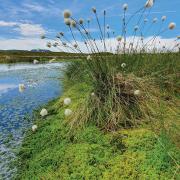Our coastline is nationally – and internationally – important for our wildlife too. The chalk cliffs at Flamborough Head support the largest breeding seabird colony in the UK, and the Humber Estuary is an internationally-important stop-off for waders, wetland birds and migratory species. The reef habitats at Flamborough are the most diverse in the UK, and the kelp beds there are part of a larger area which soaks up over 1,300 tonnes of carbon a year. Beyond them all, the vast North Sea stretches for miles, shimmering and glistening.
This incredibly special seascape and coast is home to some incredibly special wildlife. Here are just some of the coastal delights you can enjoy this summer on a wild ramble – with an ice cream to enjoy along the way!
Flamborough Cliffs, nr Bridlington
The eroding chalk cliffs with their caves, holes and stacks; the shifting tide, waves and sky; the cacophony of bird call along the shore… These are not simply the backdrops to wildlife on show, but the life and soul of Flamborough Cliffs, a nature reserve that embodies the intimate relationship between land and sea.
For a brief period between May and August, the cliffs host internationally important numbers of breeding seabirds including fulmars, herring gulls, kittiwakes, guillemots, razorbills and puffins, creating quite the raucous. Those wanting to make a day at Yorkshire Wildlife Trust’s Flamborough Cliffs reserve, a peaceful neighbour to the more well-known Bempton Cliffs, can also enjoy the abundant plant life across the cliff tops; both the base of the steps into Holmes and near Thornwick cottages are fantastic spots for wildflowers. A riot of colour fills the chalk grassland in the summer, from bird's-foot trefoil to common spotted and pyramidal orchids, and along the cliff edge beautiful shows of delicate pink thrift contrast the occasional Northern marsh orchid. Such a range of flowers attracts a number of butterflies, including small skipper, ringlet, and the scarce burnet companion moth.
Throughout the year, North Landing beach provides endless opportunities for rock pooling with starfish, crabs, fish and an array of marine molluscs to be found as well as a rich and varied carpet of seaweeds. Yorkshire Wildlife Trust runs a number of Seashore Safaris from the Living Seas Centre at South Landing, where one of our seashore experts will point out some of the most exciting shoreline wildlife you can spot.
Among its many treasures, the grey seal colony at Flamborough Cliffs stands proud. Recent visitors to the reserve may well have been treated to a sensory spectacle: the sight, sound, and – dare we say it – smell of grey seals. Hauled out on the beach, these marine mammals have made Flamborough their home, captivating visitors with their fascinating behaviours and spending their days relaxing in the Yorkshire sunshine.
Recent surveys of the local grey seal population – ironically more common on this coastline than their counterpart ‘common seals’ – have revealed that the number of seals from January onwards has shown a generally upward trend, although the overall population numbers over the past year have fluctuated as pregnant seals have left for their pupping grounds. While the increase in seal activity at Flamborough suggests there are increasing numbers of seals spending extended periods of time there, this could be for a wide range of different reasons.
These mammals face an extensive list of threats, including climate change, pollution, entanglement in marine litter and disturbance by humans. Flamborough’s grey seal colony stands as a beacon of biodiversity and natural beauty along the Yorkshire coast, and by appreciating and protecting our remarkable marine ecosystem, we can help ensure that Flamborough’s grey seals thrive for years to come.
Please be mindful of seal colonies when visiting, as disturbance can prove fatal as pubs are abandoned. Please keep a safe distance and view quietly, preferably with binoculars, do not attempt to feel the seals and keep dogs on leads
Other coastal reserves to enjoy this summer

Spurn Point, nr Hull
Possibly Yorksire Wildlife Trust’s most famous nature reserve – and definitely not one to be missed. Jutting out 3.5 miles into the Humber estuary, a summer visit to Spurn has it all; long, curving beaches with a glimmering sea stretched out, spectacular views from the top of the restored lighthouse, a fantastic café, and a wealth of wildlife to enjoy. Out at sea, harbour porpoise, seals and dolphins play; back on land, dragonflies dart amongst beautiful coastal wildflower meadows, whilst summer migrant bids wheel overhead.
Not enough? Extend your day and visit nearby Kilnsea Wetlands and Welwick Saltmarsh for more wildlife!
Filey Dams, nr Filey
Filey Dams nature reserve is the last remaining freshwater marsh of any size in the area, and a lovely little urban oasis. With three viewing hides along a short path and boardwalk, it’s also one of our easiest reserves to get around. Particularly quiet summer visitors might be lucky enough to spot one of the three British newt species – great-crested, palmate and smooth – and those out for an evening walk should keep their eyes peeled for barn owls, Daubenton and Nathusius 'pipistrelle’ bats.

Paull Holme Strays, nr Hull
Paull Holme Strays lies alongside the mighty Humber Estuary, offering spectacular views across the south Holderness landscape including local historical features. The song of skylarks is ever-present, whilst a huge variety of dragon and damselflies dart amongst the freshwater pools – tarry a while and see if you can hear the plop of a water vole! Although Paull Holme Strays is famous in the winter months for its abounding wading birds and birds of prey, it truly is an underrated visit in summer.
Harland Mount, nr Scarborough
Technically not ‘on’ the coast – but with views this spectacular, how could we leave it off? Fondly referred to as one of Scarborough’s ‘twin peaks’, this reserve offers magnificent views across the town and over the sea, and is a great place to head on a warm summer’s day for a little peace and quiet. Daisies and dog violets colour the grassland, grasshoppers chirp in the undergrowth – and if you are very, very lucky you might spot a basking common lizard.
@YorksWildlife
ywt.org.uk



























